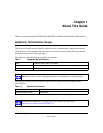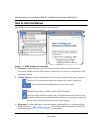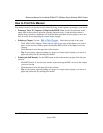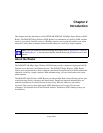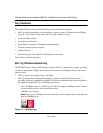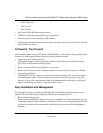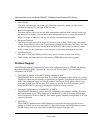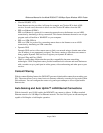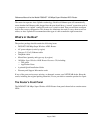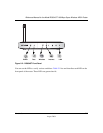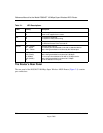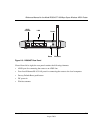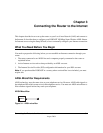
Reference Manual for the Model DG834GT 108 Mbps Super Wireless ADSL Router
2-4 Introduction
August 2004
• Smart Wizard
The router automatically senses the type of Internet connection, asking you only for the
information required for your type of ISP account.
• Remote management
The router allows you to log in to the Web management interface from a remote location via
the Internet. For security, you can limit remote management access to a specified remote IP
address or range of addresses, and you can choose a nonstandard port number.
• Diagnostic functions
The router incorporates built-in diagnostic functions such as Ping, DNS lookup, and remote
reboot. These functions allow you to test Internet connectivity and reboot the router. You can
use these diagnostic functions directly from the DG834GT when you are connected on the
LAN or when you are connected over the Internet via the remote management function.
• Visual monitoring
The router’s front panel LEDs provide an easy way to monitor its status and activity.
• Flash erasable programmable read-only memory (EPROM) for firmware upgrades.
Protocol Support
The DG834GT supports Transmission Control Protocol/Internet Protocol (TCP/IP) and Routing
Information Protocol (RIP). Appendix B, “Network and Routing Basics” provides further
information on TCP/IP.
• The Ability to Enable or Disable IP Address Sharing by NAT
The DG834GT allows several networked PCs to share an Internet account using only a single
IP address, which may be statically or dynamically assigned by your Internet service provider
(ISP). This technique, known as Network Address Translation (NAT), allows the use of an
inexpensive single-user ISP account. This feature can also be turned off completely while
using the DG834GT if you want to manage the IP address scheme yourself.
• Automatic Configuration of Attached PCs by DHCP
The DG834GT dynamically assigns network configuration information, including IP, router,
and domain name server (DNS) addresses, to attached PCs on the LAN using the Dynamic
Host Configuration Protocol (DHCP). This feature greatly simplifies configuration of PCs on
your local network.
• DNS Proxy
When DHCP is enabled and no DNS addresses are specified, the router provides its own
address as a DNS server to the attached PCs. The router obtains actual DNS addresses from
the ISP during connection setup and forwards DNS requests from the LAN.




